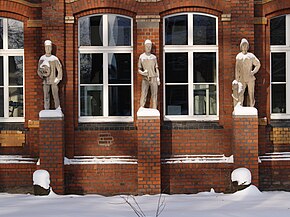Three-men-corner

The three-men-corner in Herne-Wanne originally referred to a three-part group of figures installed in 1927 by the sculptor and commercial instructor Wilhelm Braun . It depicts a miner , an inland boatman and a railroad worker and should symbolize the supporting pillars of the economy of the independent town of Wanne-Eickel at the time of installation .
Soon after the statues were erected on the wall that closed off the embankment not far from the Wanne-Eickel main station , the name was also popularly carried over to the adjacent street area: The intersection of Berliner Straße (then Herner Straße) and Hauptstraße (then Gelsenkirchener Straße) was called Drei- Men's corner. While the location retained the nickname, the statues found a new installation site in 1974 on the building of the local history and natural history museum Wanne-Eickel . In front of the main station there have been copies of the originals - regrouped - since 2003.
symbolism
- Right: Inland boatmen with oilskins and southwest , the hand on a boat as a symbol for the formerly largest port of the Rhine-Herne Canal .
- Middle: miner with miner's lamp in his left hand and a coal hoe in his right hand, symbolizing mining.
- Left towards the train station: Railway workers in uniform, in their right hand an impeller as a symbol for the Wanne-Eickel railway junction.
history
The construction of a retaining wall became necessary due to the renovation and expansion of the Wanne-Eickeler Hauptbahnhof and the expansion of the street adjacent to the newly created railway embankment. In order to loosen up the dreary facade, the city commissioned the sculptor and master craftsman Wilhelm Braun to design the area. On August 16, 1927, the three 1.70 meter tall statues made of weatherproof shell limestone were placed on the north side of Wanner Hauptbahnhof between the station overpass and the station building. Position by they were lifted with a pulley on the scale in the 2.50 m height of the embankment wall socket supports and secured with iron in the masonry. After a short time, the name three-men-corner had become popular for the location.
After the German Federal Railroad, as the owner of the embankment wall, urged the removal of the statues damaged by air pollution and as a result of the air raids during the Second World War , the city council of Wanne-Eickel approved with just one vote. The figures were then dismantled by the Köhring company on June 9, 1970 and stored in the company's building yard for several years. The figures, which were restored by the sculptor and restorer Günther Stuchtey at the end of June 1974 at the end of June 1974 at the end of June 1974 at the end of June 1974 at the request of the archivist Rudolf Zienius, found their final place . location
Up until the demolition of the embankment wall in June 1988, no agreement could be reached between the Federal Railroad and the city on the renovation of the retaining wall, and attempts by the community to re-erect the sculptures at the three-man corner failed. After the demolition, the embankment was greened and a low retaining wall was built. In December 1990, to commemorate the history of mining in Wanne-Eickel, a sheave from the Consolidation colliery was installed at the original location of the sculptures.
After completing the redesign of the station forecourt, the head of the Emschertal Museum , Alexander von Knorre , suggested the square in front of the station as the new location. In order not to endanger the original group of figures, the city council finally agreed to have replicas made by a Bochum restoration workshop. On August 12, 2003, the replicas were set up on Heinz-Rühmann-Platz as historical symbols of the Wanne-Eickeler economy. The approximately 1.70 meter tall statues made of concrete mixed with dolomite grit and a stainless steel bracket were not arranged next to each other, as originally, but on a 3.80 meter high triangular column with rib-shaped projections.
literature
- Wolfgang Berke: The book on the city of Wanne-Eickel - Myths, Cult and Records: A journey through time through the heart of the Ruhr area. Klartext Verlag , Essen 2002, ISBN 3-89861-122-1 . ( Digitized version )
- Heinrich Lührig: Wanne-Eickel in old views. European Library Publishing House, Zaltbommel / Netherlands 1992, ISBN 90-288-5419-3 .
Web links
- Chronicle of the city of Wanne-Eickel
- Heinrich Lührig: The three-man corner, a symbol of the Wanne-Eickel economy.
Individual evidence
- ^ Heinrich Lührig: Three men corner
- ^ Frank Grieger: Three men and one corner , WAZ Wanne-Eickel , April 26, 2016
- ↑ Vocational college for economy and administration of the city of Herne: Tourist route Wanne-Eickel: Wanne-Eickeler Hauptbahnhof ( memento of the original from November 9th, 2008 in the Internet Archive ) Info: The archive link was inserted automatically and not yet checked. Please check the original and archive link according to the instructions and then remove this notice.
- ^ Gesellschaft für Heimatkunde Wanne-Eickel eV: The three-men-corner: a symbol of the Wanne-Eickel economy. ( Memento from April 17, 2008 in the Internet Archive )
Coordinates: 51 ° 31 '54 .2 " N , 7 ° 9' 53.2" E


